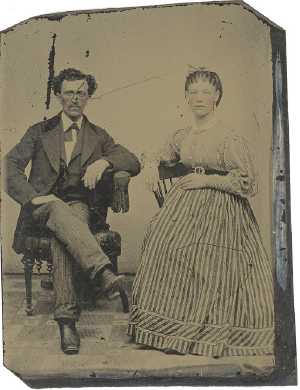Sign up for the Family Tree Newsletter Plus, you’ll receive our 10 Essential Genealogy Research Forms PDF as a special thank you!
Get Your Free Genealogy Forms
"*" indicates required fields

Sanda knows the photographs once belonged to her great-grandmother Elizabeth Daigle, who married Adolphe Benoit in Coaticook, Quebec, in 1892. At least two generations of female ancestors handled these pictures before Sanda inherited them. Knowing the provenance or history of the collection provides her with a place to begin. Since she knows that these images belonged to either the Benoit or Daigle family, her next step is to establish a time frame for each image one clue at a time. Let’s explore the identifying information in this image.
Type of photograph
This image is a tintype, a photograph on metal. Tintypes were invented in 1854, so we know that the image was created after that year. Establishing a beginning date for a time frame is the first step in identifying the image.
Woman’s clothing
The young woman in this tintype had a sense of style that’s evident in the shape of her sleeves (full, with a tight cuff), full skirt and hairstyle. All of these costume details date the image to the 1860s. In an era when most women wore dresses either made from a single fabric or featuring a solid bodice with a patterned skirt, this woman chose to stand out. Her choice of different patterned fabrics for the bodice and skirt is a little unusual. In Who Wore What?: Women’s Wear 1861-1865 (Thomas Publications, $29.95), Juanita Leisch suggests that women younger than 25 took more fashion risks (as they do today), so this ensemble provides a possible age range for the woman. The painstakingly detailed hairstyle also supports the theory that this is a young married woman. Accessories are typical for the 1860s—a belt that accents her waistline, drop earrings, and a small lace collar on the dress.
Her dress provides additional clues. For instance, the waistline falls over her stomach rather than at her natural waist, as most dresses of the period did. Comparing this photograph to others from the same time period, it appears that she isn’t wearing a corset. This could account for the short-waisted appearance of the dress. It’s also possible that she was pregnant. The skirt is very full where her hand is resting.
Man’s clothing
The man wears a loose-fitting sack coat with wide lapels and a velvet collar, a shawl-collared vest, striped pants and square-toe boots. His style is typical for men in the 1860s.
Poses
While the man is comfortably seated in a chair, the woman is not. If you try to imitate her pose with a kitchen chair, you end up resting on the edge, without fully sitting down. It’s an uncomfortable position, and I’m not sure why she’s sitting that way. It’s possible that the photographer placed additional objects on the chair to help support the pose. The way the photographer posed their arms visually links them as a couple.
Props
Chairs with fringed upholstered arms often appear in pictures from the 1860s, but the chair the husband sits in has knobby design elements visible at the front of the seat. I’ve never seen a piece of furniture that looks exactly like this one. It could be a regional design. If Sanda could locate a book on Canadian furniture styles, she might be able to date the chair and narrow the picture’s time frame even further.
Adding up the clues
This is a difficult photograph to date because it was taken in Canada. While Canadian and American fashions are similar, there may be subtle differences— such as this woman’s unusual hairstyle—that are the result of local or personal taste.
Clothing clues suggest the picture was taken in the mid- to late 1860s, when women commonly wore belts and hairnets. By researching the furniture and comparing the image to other photographs taken in that part of Canada, Sanda may be able to narrow the time frame to just a few years.
One thing is clear. Elizabeth Daigle Benoit was not the first person to collect these images. The two individuals in this photograph were born in the late 1830s or early 1840s, and posed for this portrait as a young married couple in the mid-1860s. Elizabeth Benoit married in 1892 and acquired the family photographs after that date. This couple is from her parents’ generation, which means there are several possible identifications for this couple. They might be Elizabeth’s or Adolphe’s parents. Sanda will need to use her genealogical data to know for sure.
Her next step is to try to locate portraits of those candidates to see if any of them match the couple in this picture. She can do this by networking with relatives and posting queries on online message boards. It’s a big job, but by dividing up the tasks, it can become manageable.
ADVERTISEMENT

